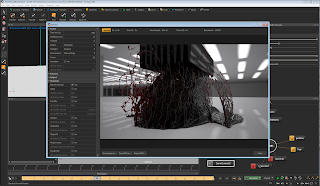UPDATE : Just managed to get the sim times down, while achieving way
more detail with the PBD Solver . Higher resolution and only 3hrs 27
mins on my home machine, i73930 (thanks to Ivan Alduan for the tips:)
The result mesh is also way better.
this scene served as a stress test for the dyverso solver, especially with fast moving geometry.
the setup for this test is based in object emission, selecting faces from the geometry, and emitting from those.
again, a pretty simple scene setup, with only a handful of nodes in the RealFlow scene. geometry coming from Maya, using one of the mocap libraries and exporting it using the RFConnect, available from
realflow.com/try.
we made use of the lock feature to have some initial fluid after running the simulation for 25 frames in lock mode.
the dyverso domain has high values for viscosity, surface tension and also the the external pressure modified, trying to contain the fluid from expanding, something that would be expected with a fast moving object like this one, which is emitting the fluid, but also colliding with it.
the mesh uses openVDB filtering, with some small values.
tip#1:
the trick with Dyverso is to have clear which solver suits our needs better
- if we want something really fast, trading quality(although it can have great detail if we modify the substeps) dy-PBD or Position Based Dynamics is our solver
- if we want the same detail we can get with the "old" Standard Particles, then dy-SPH is what we should choose. it will still be way faster than the old solver.
tip#2:
with dy-PBD, you can still fine tune your sims accuracy, and level of quality, by raising the substeps in your simulation options. the initial test for this scene, was using the adaptative substeps that come by default, together with the "Use geometry velocity" setting being activated. This setting ensures that the substeps are going to adapt to suit the geometry's velocity.
adaptative substeps
If we don´t need an accurate simulation, like in this case where things end up flying in a slightly chaotic way, we can speed up the simulations dramatically, by using fixed subteps instead.
Running on fixed low substeps is one of the beauties of the PBD solver.
In the case of using fixed substeps, it doesn´t really matter if we have or not "use geometry velocity" selected, the maximum substeps will be the ones we have fixed our value to.
The following images show two renders, one from the adaptative, the other from the fixed substeps sims. The adaptative simulation took slightly over 14hrs to simulate, the fixed one around 1h20ms. Pick your favorite ;)
adaptative substeps
fixed substeps
g-)

















